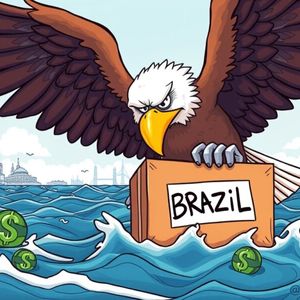US Brazil Tariffs: A Staggering 50% Levy Unveiled, Sparking Global Economic Jitters
9 min read
BitcoinWorld US Brazil Tariffs: A Staggering 50% Levy Unveiled, Sparking Global Economic Jitters In the ever-shifting landscape of global economics, sudden policy changes can send ripple effects far and wide, often touching unexpected corners like the cryptocurrency market. Recently, a significant announcement has emerged from the White House, detailing a new executive order signed by former President Donald Trump. This order introduces a substantial 40% tariff on goods from Brazil, escalating the total tariff rate to a staggering 50% as part of a renewed tariff authorization. This development, as reported by JinSe Finance, immediately raises questions about its potential impact on international trade, commodity prices, and indeed, the volatile world of digital assets. How will these US Brazil tariffs reshape the economic outlook, and what might it mean for your crypto portfolio? Understanding the New US Brazil Tariffs : What Just Happened? The news of increased US Brazil tariffs has caught many by surprise, particularly given the magnitude of the hike. The White House’s decision to impose an additional 40% tariff, bringing the cumulative rate to 50%, marks a significant escalation in trade policy. This move is framed within a ‘renewed tariff authorization,’ suggesting a broader strategy, though specific justifications often cite concerns over trade imbalances, currency valuations, or national security interests. The Executive Order: The core of this development is a newly signed executive order by former President Trump. Such orders bypass traditional legislative processes, allowing for swift implementation of policy changes. The Magnitude: An additional 40% tariff on top of existing duties means a total of 50%. This is a substantial barrier to trade, making Brazilian imports significantly more expensive for U.S. consumers and businesses. The Source: The initial report came from JinSe Finance, a reputable financial news outlet, lending credibility to the announcement. Historical Context: While the specific reasons for this renewed authorization are not fully detailed in the initial report, it echoes previous periods of heightened trade tensions under the Trump administration, where tariffs were often used as a tool to exert economic pressure and renegotiate trade terms. This aggressive stance on trade could signal a shift in U.S. foreign economic policy, potentially influencing other trade relationships and global market dynamics. The immediate question on everyone’s mind is, what will be the fallout? The Immediate Fallout: How Do US Brazil Tariffs Impact Trade and Economies? The imposition of steep US Brazil tariffs is not merely a political statement; it has tangible economic consequences that will be felt across various sectors. The primary goal of tariffs is often to protect domestic industries by making imported goods less competitive. However, they also come with a host of challenges. Impact on Brazil’s Economy: For Brazil, the immediate impact could be severe. The U.S. is a major trading partner, and a 50% tariff effectively prices many Brazilian goods out of the U.S. market. This could lead to: Reduced Exports: Brazilian exporters will struggle to sell their products in the U.S., potentially leading to job losses and reduced revenue in key industries. Currency Devaluation: A decline in exports could put downward pressure on the Brazilian Real (BRL), making imports more expensive for Brazilians and potentially fueling domestic inflation. Economic Slowdown: Reduced trade and investment could contribute to an overall economic slowdown or even recession in Brazil. Impact on U.S. Economy: While intended to benefit U.S. industries, tariffs also have a boomerang effect: Higher Consumer Prices: U.S. consumers will likely face higher prices for goods that were previously imported from Brazil, as businesses pass on the increased costs. Supply Chain Disruptions: Companies relying on Brazilian inputs will need to find alternative suppliers, which can be costly and time-consuming, leading to potential delays and inefficiencies. Reduced Choice: Consumers may have fewer options for certain products as Brazilian imports become less viable. Consider the agricultural sector, for instance. If the tariffs heavily impact Brazilian agricultural exports like coffee, soybeans, or orange juice, U.S. consumers might see prices for these staples rise, while U.S. farmers might face less competition but also potentially higher input costs if tariffs affect their supply chains. Beyond Bilateral Trade: Could US Brazil Tariffs Spark a Wider Economic Ripple? The implications of the new US Brazil tariffs extend far beyond the direct trade relationship between the two nations. In an interconnected global economy, a significant trade dispute between major players can trigger a chain reaction, influencing global commodity markets, investment flows, and even geopolitical stability. Potential for Retaliation: Brazil may respond with retaliatory tariffs on U.S. goods, escalating the trade conflict. This ‘tit-for-tat’ scenario can harm industries in both countries and reduce overall global trade volumes. Other countries might also take note, potentially leading to increased protectionist measures worldwide. Impact on Global Supply Chains: Many multinational corporations have complex supply chains that crisscross borders. Tariffs on Brazil could force companies to re-evaluate their sourcing strategies, leading to higher operational costs and potentially less efficient production. This uncertainty can deter foreign direct investment (FDI). Commodity Market Volatility: Both the U.S. and Brazil are significant players in global commodity markets, particularly in agriculture and raw materials. Disruptions to their trade could introduce volatility, affecting global prices for goods like soybeans, iron ore, and crude oil, which in turn impacts economies worldwide. Investor Sentiment: Geopolitical tensions and trade wars tend to make investors nervous. This can lead to capital flight from emerging markets, increased demand for safe-haven assets, and a general slowdown in global investment, impacting growth prospects across various economies. The situation highlights the delicate balance of international trade and how quickly political decisions can translate into economic challenges that reverberate globally. The Crypto Connection: How Do US Brazil Tariffs Influence Digital Assets? While US Brazil tariffs might seem purely economic and geopolitical, their ripple effects often find their way into the cryptocurrency market. Digital assets, particularly Bitcoin, are increasingly viewed by some as a hedge against traditional market instability and inflation. Here’s how these tariffs could influence the crypto space: 1. Increased Economic Uncertainty: Tariffs create uncertainty, which can lead traditional investors to seek alternative assets. When fiat currencies and stock markets face headwinds due to trade wars, some capital may flow into cryptocurrencies, perceived as uncorrelated or even inverse assets. Bitcoin, often dubbed ‘digital gold,’ tends to see increased interest during times of geopolitical and economic turmoil. 2. Inflationary Pressures: If tariffs lead to higher import costs and reduced supply, inflation could rise in the U.S. and Brazil. Cryptocurrencies, especially those with fixed supplies like Bitcoin, are sometimes seen as a hedge against inflation, as their value is not directly tied to the printing presses of central banks. 3. Emerging Market Capital Flight: For Brazilians, facing potential currency devaluation (Brazilian Real) and economic instability, cryptocurrencies could become an attractive option for preserving wealth. This phenomenon has been observed in other emerging markets experiencing economic crises, where locals turn to stablecoins or Bitcoin to protect their savings. 4. Demand for Stablecoins in Trade: While not a direct solution, increased friction in traditional cross-border payments due to tariffs or currency controls could theoretically boost the utility of stablecoins for international transactions, offering a more efficient and less regulated alternative for businesses seeking to bypass traditional banking hurdles. 5. Regulatory Scrutiny: As traditional financial systems face pressure, governments might either increase scrutiny on crypto (viewing it as a threat to capital controls) or, conversely, explore it as a means to facilitate trade outside conventional channels. The response will vary by jurisdiction. It’s important to note that the crypto market is influenced by a multitude of factors, and while macroeconomic events like these tariffs can play a role, they are just one piece of a complex puzzle. However, the narrative of Bitcoin as a safe haven or a hedge against economic instability gains traction during such periods. Navigating the Storm: What Can Businesses and Investors Do Amidst US Brazil Tariffs ? The emergence of significant US Brazil tariffs underscores the need for proactive strategies for both businesses and individual investors. Adapting to these new economic realities is crucial for mitigating risks and identifying potential opportunities. For Businesses: Supply Chain Diversification: Businesses heavily reliant on imports from Brazil should immediately assess alternative sourcing options. Diversifying suppliers across different countries can reduce vulnerability to country-specific tariffs. Cost Analysis and Pricing Adjustments: Re-evaluate production costs and adjust pricing strategies to account for higher import duties. This might involve absorbing some costs, passing them on to consumers, or exploring new markets. Hedging Strategies: For businesses engaged in international trade, currency hedging strategies can help mitigate the impact of potential currency fluctuations in the Brazilian Real. Advocacy and Lobbying: Engage with industry associations and government bodies to voice concerns and advocate for policies that support free and fair trade. For Investors: Portfolio Diversification: Ensure your investment portfolio is well-diversified across different asset classes and geographies. This can include traditional assets like stocks and bonds, but also considering alternatives. Consider Safe-Haven Assets: During times of economic uncertainty, assets traditionally considered ‘safe havens’ such as gold, certain government bonds, and increasingly, Bitcoin, may become more attractive. Monitor Global Economic Indicators: Stay informed about macroeconomic trends, trade negotiations, and central bank policies. These factors will significantly influence market movements. Assess Crypto Exposure: For those in crypto, understand that while it can act as a hedge, it’s also highly volatile. Consider dollar-cost averaging and long-term holding strategies rather than speculative short-term trading based on news events. Research and Due Diligence: Before making any investment decisions, particularly in volatile markets like crypto, conduct thorough research and consider consulting with a financial advisor. The key is adaptability and informed decision-making. The global economic environment is constantly evolving, and the ability to pivot and adjust strategies will be paramount. A Compelling Conclusion: The Unfolding Impact of Trade Tensions The imposition of a 50% tariff on Brazil by the U.S., as announced by the White House and reported by JinSe Finance, marks a significant moment in global trade relations. These substantial US Brazil tariffs are set to create immediate economic challenges for both nations, impacting trade flows, consumer prices, and the stability of supply chains. Beyond the bilateral relationship, such aggressive trade policies risk sparking wider economic ripples, potentially affecting global commodity markets and investor sentiment worldwide. While the full extent of the fallout remains to be seen, one thing is clear: the era of interconnected global economies means that trade disputes, no matter where they originate, can have far-reaching consequences. For the cryptocurrency community, these developments serve as a potent reminder of digital assets’ potential role as an alternative during times of economic uncertainty. As traditional markets grapple with the implications of protectionist policies and geopolitical tensions, the appeal of decentralized, inflation-resistant assets like Bitcoin may continue to grow. Navigating this complex landscape requires vigilance, adaptability, and a deep understanding of how global events can shape financial markets, both traditional and digital. Staying informed and strategically positioning oneself will be key to weathering the storm and seizing new opportunities in an ever-evolving global economy. Frequently Asked Questions (FAQs) Q1: What exactly are the new US Brazil tariffs? A1: The U.S. has imposed an additional 40% tariff on goods from Brazil, bringing the total tariff rate to 50%. This was enacted via a new executive order signed by former President Donald Trump as part of a renewed tariff authorization. Q2: How will these tariffs affect U.S. consumers? A2: U.S. consumers may experience higher prices for goods imported from Brazil, as businesses pass on the increased tariff costs. There might also be reduced product variety as Brazilian imports become less competitive. Q3: What is the potential impact on Brazil’s economy? A3: Brazil’s economy could face significant challenges, including reduced exports to the U.S., potential job losses in export-oriented industries, and possible devaluation of the Brazilian Real, leading to domestic inflation. Q4: How do these US Brazil tariffs relate to the cryptocurrency market? A4: Increased economic uncertainty and potential inflation caused by tariffs can drive some investors towards cryptocurrencies like Bitcoin, which are sometimes seen as a hedge against traditional market instability and currency devaluation, especially in affected emerging markets. Q5: Are there any historical precedents for such high tariffs? A5: While a 50% tariff is substantial, trade wars and high tariffs have been part of economic history. The Trump administration, in particular, previously used tariffs as a key tool in its trade policy with various countries, including China. Q6: What should businesses do to mitigate the impact of these tariffs? A6: Businesses should consider diversifying their supply chains, re-evaluating pricing strategies, exploring currency hedging, and engaging in advocacy to navigate the challenges posed by these tariffs. If you found this article insightful, consider sharing it with your network! Stay ahead of the curve by sharing this analysis on social media and discussing its implications for global trade and the crypto world. To learn more about the latest global economic trends , explore our article on key developments shaping Bitcoin’s role in institutional adoption . This post US Brazil Tariffs: A Staggering 50% Levy Unveiled, Sparking Global Economic Jitters first appeared on BitcoinWorld and is written by Editorial Team

Source: Bitcoin World



